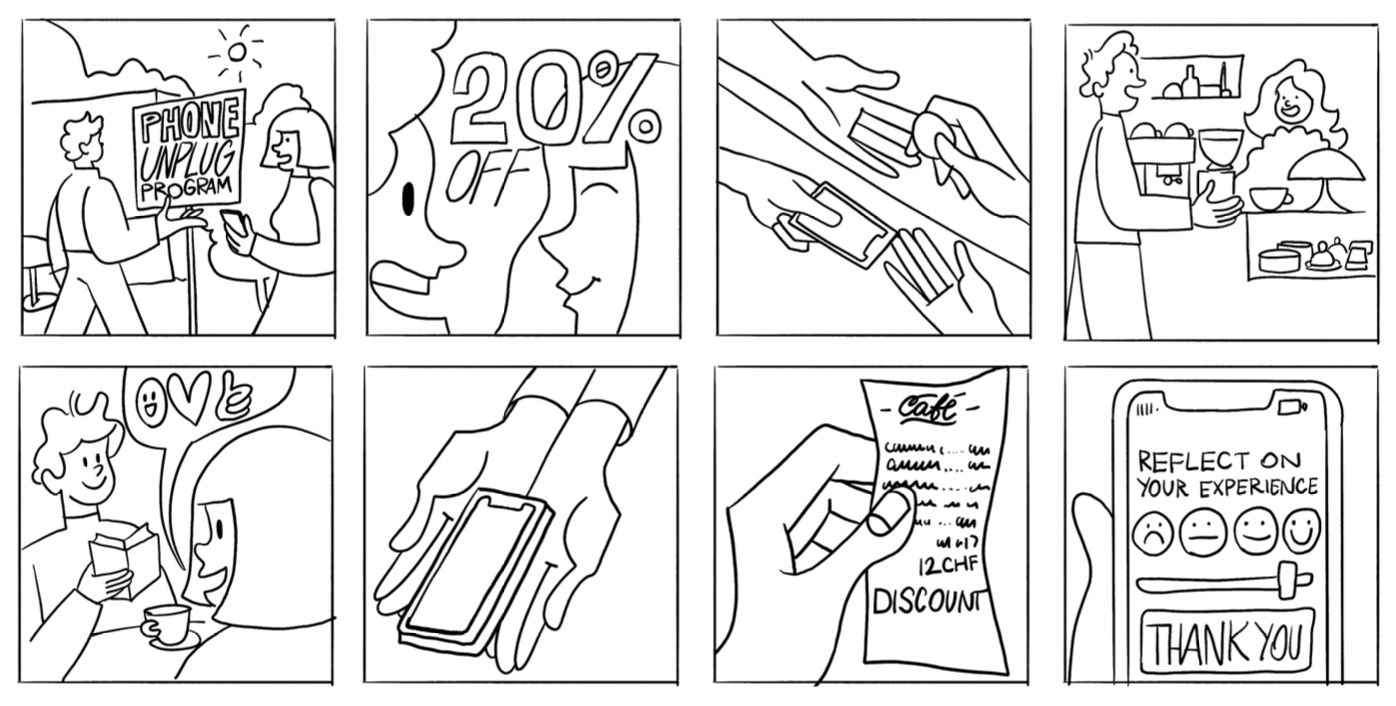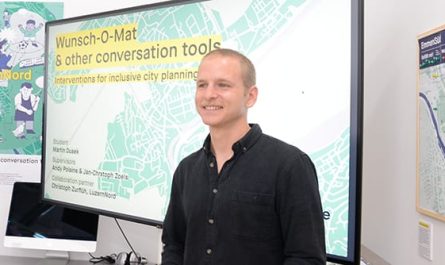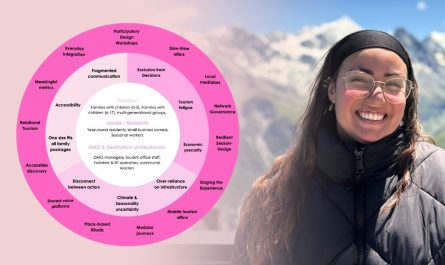In this interview 21-minute interview, we talk with Sofiia Kaminska, a Digital Ideation master student who dabbles in Service Design. She shares her prototypes, lessons learned from that process and who shouldn’t join such a Master Design program.
The video interview
Interview summary
Sofiia shares three prototypes that could help zillennials prone to anxiety build a more mindful relationship with digital media.
- individual-focused prototypes
- collective-focused prototypes
- cultural-focused prototypes
We then go deeper and reveal some lessons that her work in progress teaches us, for example:
- Break boundaries: It’s important to break down mental boundaries like the label of your specialization in order to integrate learnings from other discipline like digital ideation, product design, eco-social design, and service design can lead to more innovative solutions.
- Use simple tests: Simple and accessible testing methods, such as social media or peer feedback, can be effective in the design process.
- Keep on testing: It’s important to understand that prototyping is an ongoing, never-ending process that evolves with user feedback and changing needs.
- The end is not the end: We should view a final Master presentation as a stepping stone, rather than the end of a project, as such projects can then continue to be explored as startups, side projects or in-house in your next job.
At the end of this conversation Sofiia shares for who a Master Design program is and who shouldn’t join.
- For who it isn’t: Such a program is not for those expecting all information to be handed to them. It requires active participation and decision-making. The program offers a lot of freedom and autonomy, which can be both a blessing and a curse.
For who it is: The program can be seen as a ‘career development sabbatical,’ where students can deeply explore their passions or fields of interest. Therefore students should have a deep passion for a theme, as they will be working on it for a long duration.
Thanks Sofiia for sharing your prototypes and letting the world have a behind the scenes look at what happens in the master.
Sofiia’s slide deck
Transcript
Show the transcript
This transcript was fully generated using Descript. The transcript wasn’t corrected. Which means it can be pretty creative, funny or wrong at moments.
Introduction
Daniele: I’m super excited that today you get all to meet Sofiia. Why? because Sofiia is someone who will help me fix a problem that I get asked so many times, which is:
Daniele, what do people do in this Master Design of the HSLU?
And it’s a big question. And obviously, I don’t want to have Sofiia answer for 24 hours, so we’re going to keep it short, but Sofiia will present you a few of the things that she’s doing, and especially a bit about the prototyping of services.
So welcome on the stage, Sofiia.
Sofiia: Daniele, thank you for having me. Yes, the theme of prototyping is quite frustrating for lots of us when we start, but then if you get hands on, it becomes more clear. So I’m really happy to share some of the things I’ve worked on lately, and we can get started.
What is Sofiia’s project about?
Sofiia: So my theme is building a mindful relationship with digital media for millennials prone to anxiety.
I’m a student of digital ideation, but during my project, I actually got more into service design and eco social design. So that’s also the thing that if you’re in one master, you can get the best of all of the four that we have. So the first question, maybe to clarify who are zillennials?
Zillennials are my target audience, people who were born between millennials and zillennials. And it’s not that much about the age, but about their behaviors. and especially about their digital behaviors and online presence. During my research, I found the most relevant During my research, I found the most complicated things that could be found and basically the main problems.
And the things I’m working on firstly, are the attention and prolonging of attention span while using digital media and overall in everyday life, then the information overload and how can we pull the information from the web and online instead of being pushed with and time management overall. The feeling of the lost time, how can we eliminate that?
And my main goal is basically mitigate the negative consequences of using digital media and maximize the positive ones. So these are Kind of a lots of text that nobody actually needs, but if you want to get look at it, you can pause and Look at them closely, but my main goal is basically empowering Selenials for digital wellness and their well being.
How does Sofiia approach prototyping?

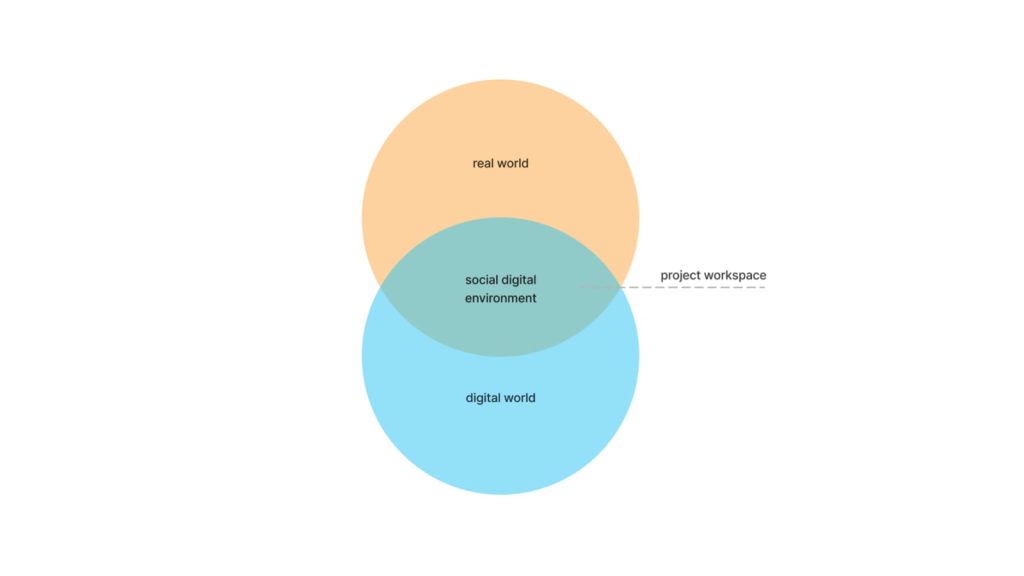
Sofiia: So I had worked on my prototypes half a year ago and now it’s also really interesting to look at them because my Theories changed greatly, and my methods as well. I tried some of them, I presented some of them, and it’s interesting to see how my previous prototypes, which I made several months ago, are mainly digital.
And for the problem that we have in the digital realm, it was also interesting to see how can we digitally solve them. I actually shifted. You can see here like a podcast idea, a documentary idea, some bite sized educational videos, and An app or some pieces of hardware. So I shifted from them.
And today I’m going to talk about different ones because I also realized that division between real world and digital world, as lots of researchers also do, is not really applicable to this situation because our real lives are actually extending in digital environment. So one of the methods or the frameworks are used here is a theory of change.
And basically we start with something that we discovered, then we define it, and then we prototype. And actually today or now, I’m going to talk about the prototypes I developed in this stage. My current prototypes tackle not only individual problems, but also collective and cultural problems. And I want to make a change in all of them, or at least try.
That’s why I’m making my prototypes. And we’re going to start with. Individual ones, then collective ones, and then we’re going to get to cultural ones.
Example of individual-focused prototypes

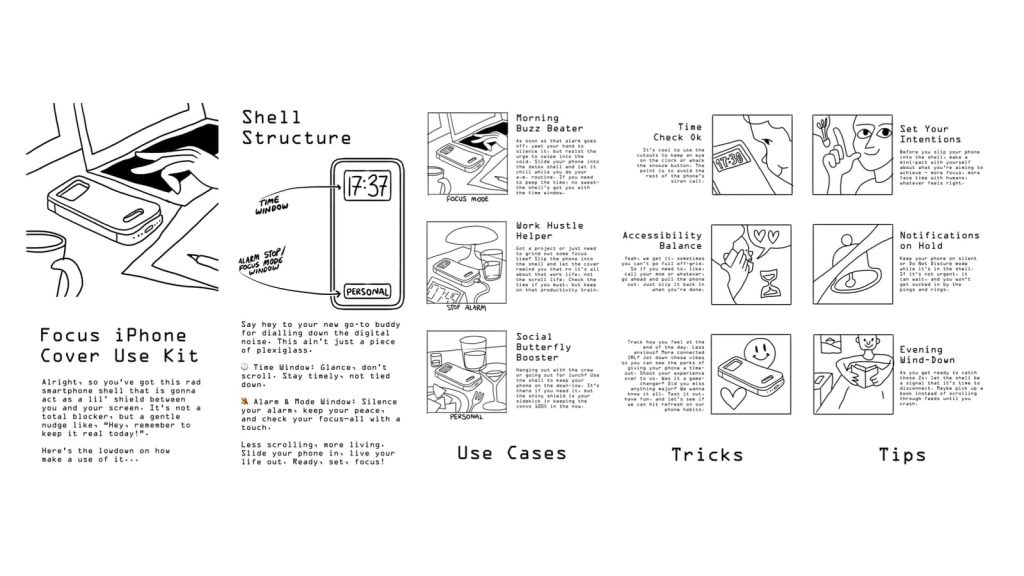
Sofiia: So individual. The first prototype I made was the Focus iPhone cover. I had an idea that if basically we don’t push the boundaries to the extent that we eliminate the phone.
which is the main source of everyday destruction overall, but we just set the distraction between us and the screen. Then we can have some kind of a behavioral change. So I started with the idea, the sketch, then I made some covers in different materials using laser cut. That was actually really funny because I forgot to mention it here, but I also made like a printed sticker that I tried on the phone and then I developed it a bit further.
And then I And I already came up with some of the use cases where it can be used, so I already finished instructions for people who are going to test them, and I already sended them. These are the users cases when this focus cover could be used. So when you wake up, the morning is one of the most vulnerable times for individuals to get really into using of their devices and set the mood for the day.
So you could use it in the morning. You have this two windows, one for screen time and the other one for stopping the alarm. The second use case could be the focus mode when you work and you don’t want to be distracted by notifications that pop up on the screen. And also the personal mode when you trigger to get your phone, but then you see this car and you’re like, Yeah, I actually wanted to hang out offline more, so maybe I’ll just leave it alone.
So these are instructors. This is. Instructions I developed and sent to my testers who were willing to test them and now I’m waiting for the feedback from them. And after that, I’m gonna either ditch this idea or develop to some extent that it might be more, more valuable.
Example of collective focused prototypes
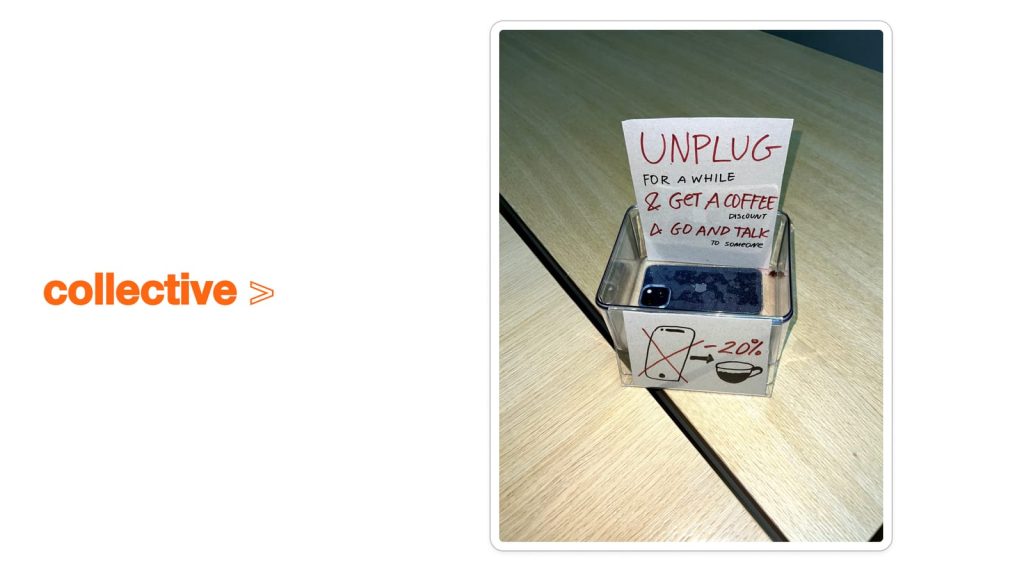
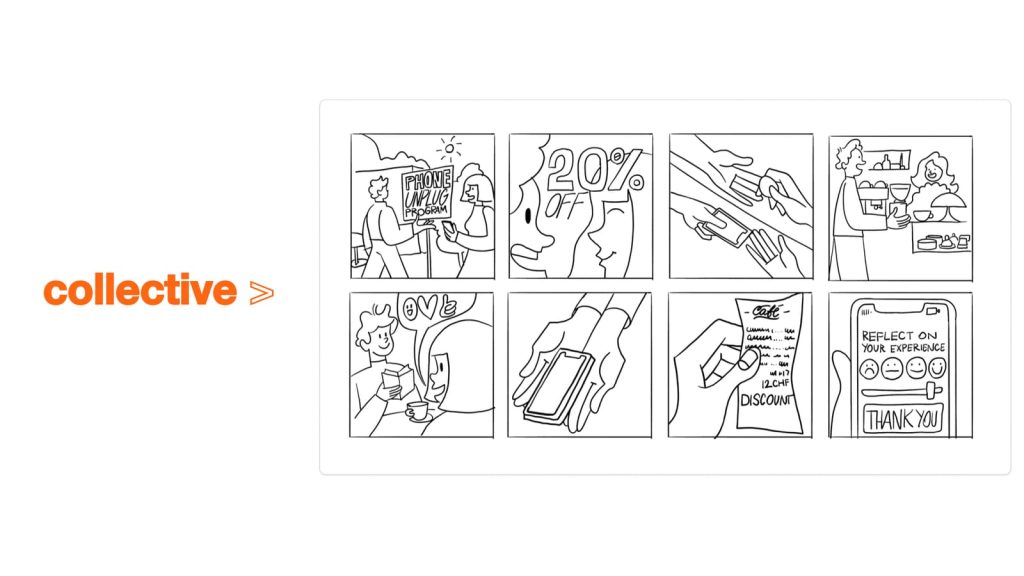
Sofiia: So the collective action that I wanted to make was more related to the public spaces that we enter a lot and public spaces Overall, in their name has this prompt to socialize with people.
But the thing that we see right now is in lots of the cafes, we have people just like sticking in their phones and not really communicating with each other. And especially with younger generation, that’s quite a struggle that they. Face ’cause they prefer social interaction via messengers, not even calls, and not even personal communication.
So I wanted to kindly prompt people to leave their phones in the counter and maybe engage with some other people who are present in the space or with themselves doing some other works. For example, you could go in the cafe. Then see the 20 percent off on the coffee or overall on the menu if you leave your phone at the counter and then you go and either have a small chat or read a journal on the coffee table.
And then when you receive your phone back, you get a discount. And then the, one of the important parts of this reflection is basically evaluate your experience and to make a summary or results to yourself. How do you feel after? And this is the prototype I made, basically the prototype for this unplugged station where you leave your phone.
I also gathered some feedback, basically sharing it in my stories. People know which project I’m doing, so they’re willing to share. 90 percent of people were willing to get, to take part in this. And some of them just expressed their concern about their phone being stolen, so they either need to trust in the cafe they go, or they need to have a secure box to which they have a key.
Example of cultural focused prototypes
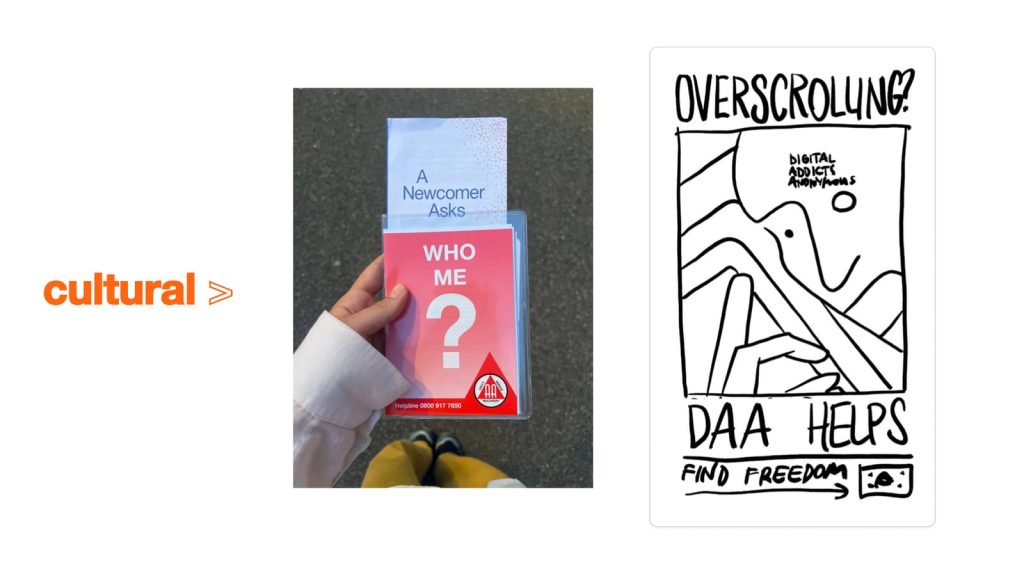
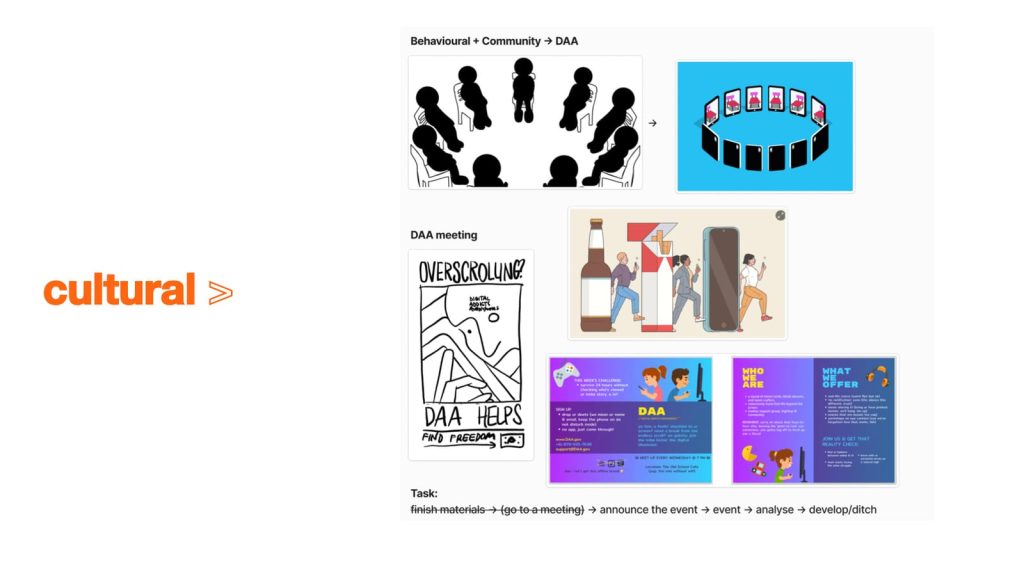
Sofiia: And cultural change I wanted or tried to make is my concept of Digital Addicts Anonymous. Maybe some of you’ve heard of AA. This is the program that helps people who struggle with alcoholism. So Alcoholics Anonymous, and I wanted to get their methods and apply them to digital realm. Or maybe even speculate a bit and treat digital usage when it’s over abusive as an addiction as well.
So with my prototype, I wanted to create this connection as addiction. As some people might have to their phones when they don’t control themselves, a lot of the jargon we use to describe our feeling related to digital media usage is actually correct. containing lots of the words that we use for addictions.
So I made this DAA, Digital Addicts Anonymous, brochure, which was a test to basically spread around the atelier and see what my colleagues will say. I gathered the feedback and concerns as well, and then I went further and decided that I want to make this meeting for real. And I gathered some information online.
I also shared it in my Instagram stories. And people were actually really willing to meet offline. And during my workshops before that I made prior to this prototyping, people expressed their willingness to go offline and meet more often. So I thought not only of this speculative design targeted to startups make people think about using of their digital media as an addiction, but also actually handling this meeting and move it, moving it further.
So I’m finishing my materials right now and I will create like a short platform that could be scanned on the posters. Then I’m gonna choose the date and choose the location. Threaded posters, I think firstly in our university and see how many people come and what they share and basically during the meeting half improvise, half have materials prepared and then get the outcome of that.
I did some of the prior prototyping with this poster sketch and also I wanted to see how it works in real life, and I went to the real AA meeting as an observer and talked to the organizers on the method they use to help people with their struggles, and it helped me greatly to understand the value of the community within this programs.
So my next steps for now are testing all of the prototypes, then making more of them, and then building further the final idea or several ideas that I might feel that they contribute the most. Yes, I think that’s all for now. I’m looking forward to sharing more soon. And if you have any questions, I would be really happy to answer them.
Lessons from Sofiia’s prototyping journey
Daniele: Thank you so much for sharing all of that. And I think it’s full of great lessons. So when I’m looking at what you have done in just this tiny few minutes of the stuff that you have shared, I think there are already some very rich lessons in it. One of the first lessons that I see that people can see between the lines of what you have shown is that, you prototype a lot.
Like you have made a few prototypes, you now are doing more prototypes and you already even say, I will do even more, so it shows that, it’s really a thing of practice. It’s like a muscle or for people who like karate or this kind of stuff, you just repeat a same movement, same idea.
And that’s prototyping is like same. It’s through this repetition of this action, suddenly you learn something and you say, Oh, there, there is something. And I love how you maybe even unemotionally said, I’m going to test this and maybe I’m going to ditch it and I’m going to go to the next one.
And I think this is really what we learn also from you, which is Hey, these are just tiny things I’m going to put out and see how they work. A second thing that a second lesson that I see in what you shared is, You’re starting with digital ideation, then you’re going to product design, with the kind of physical case.
Then suddenly you’re saying, Oh, no, I’m going to go more in eco social design, like with the kind of cultural thing. Then suddenly you’re going to a cafe, and then it’s service design. And that’s also showing me, that it’s not thinking in these boxes of This is digital ideation and do anything else or this is service design and I can’t have fun in digital ideation. This is also a great lesson that, you are allowed yourself to wander around and see and steal stuff from all of these different disciplines. And the one last that I would just, because there’s obviously much more to say, but I’m just going to pick one last, which I loved from what you shared is this very simple test.
You spoke about your own Instagram, how you use that, to do tests or how you use the place where students are already, which we call the atelier. And you said, Hey, I’m
just going to test it with my friends. And my student friends, and also, going further. And so it shows really that, testing can be very simple, can be more complex and that you’re really playing with all of this.
What’s the stage of this prototyping?
Daniele: But I have a question for you, which is, so now people who are maybe interested in doing a master, they say, Oh, this is all interesting stuff. But, this might be like the final work, obviously, it’s so good. Could you maybe reveal where you are in your own project? Is this final stuff?
Is this the stuff that is, is this your final thesis? Or is this kind of your work in stage?
Sofiia: prototyping is always a work in progress thing, and it was also really valuable for me to understand that in any product you create, it’s a never ending process. It’s like a startup that constantly develops itself and move further and any, if you would talk about digital ideation and just, or services or yeah, service or app would be a good example.
If you use an app, you always think there is an update, there’s going to be an update, another update, because only by exchange from the user or the target audience that is aimed for your product. You can share the things you did, then get the feedback and improve it. And then it’s like a constant overlapping process.
So with this prototypes, we were talking about the final thing that is going to be my presentation. First, I don’t treat my workshop as the final presentation that will end my project and I’ll ditch it because I really feel a passion towards it. And the second, that might be several steps that might lead me to the new idea.
That will be closer to my final aim and to the thing that people want, or they don’t even know they want, but they try it and they come up with their new wishes. So for me, this is like a small steps in different areas that my LingQ Me to either one idea or several new ideas that will be more clarified for the aim of basically giving sovereignty over your digital media use to my target audience or to creating the environment that will conduce you to feel more freed or not addicted.
It’s really impressive, to me to see that, You’re not seeing, what we call workshop, which is like this final exhibition of your final work that you don’t see that, as the final thing of your project. And I think this is also something that is quite particular here, which is you’re in the middle of that process and still, you’re still prototyping and you consider that even after you will continue with that.
Daniele: So even after you’re. You have your fancy master degree you’ll still continue to have fun on that project. And I think that shows, how much passion people put in those projects, because there are two year projects that you then feel it could be more fun. startup after or could land you to another job or just, a side that you run for years because it’s, you’re just too passionate about.
And I think this is something that I deeply find interesting in this kind of world.
Who is the Master Service Design for?
Daniele: Another question for you is, so now people see a little bit from the behind the scenes and for people, who are asking themselves, Oh, would I like to be the next Sofiia? Maybe, could you share? Who, for who this master is, and for who it definitely isn’t.
Sofiia: With which one is better
Daniele: Obviously, your own
Sofiia: Yeah, I’m just thinking, is it better to start with is or isn’t? I think we can start with isn’t. This master is definitely not for people who assume that you’re gonna go here and people will just give you everything on the plate. And also tell you the instructions how to do that, because especially in masters, at least here in high saloon, I feel that everybody is familiar with this.
Prompting, I’m using this word prompt a lot now is leading you towards your own path. You’re the master of your own master and only you decide what are you going to do. Nobody’s going to tell you this is the right way or the wrong way. They can only give you feedback. And this is also your responsibility to either take it or ditch it because you are going to have different feedbacks. And on, only on one idea, you can go to 12 coaches and all of them will tell their personal view or their professional view on this thing. And then you’re only in the power to decide what is yours and what are you taking further.
So people who are assuming that they’re going to come to a master’s and everybody is going to teach them all of the methods, all of the I don’t know, all of these things as an instruction, it’s not the thing. It’s really at some point ambiguous and really freeing experience, which sometimes could be frustrating because then you really learn how to make decisions yourself as in real life.
Like when you have so many options to go to work for someone and create your own business, like what do I get? Where do I go? Yeah I would think you would be disappointed if you think that you will come here and you will learn some software or some methods and then you will have a clear path where do you go and what you should do in life.
And for whom it is, I entered this master’s to not get a master’s degree. So for me, this workshop thing is also not an aim. It’s a good thing to have a deadline to make things done until then, because research never ends. And I would just read the books till the end of my life, so regarding this theme.
And if you have a passion towards something, or you want to learn about like a sphere in design, I Like, you can choose the options, like one of these four, but also understand that it’s super collaborative and you will exchange between all the four flaws of Master our streams. And yeah, and have the ability to shift your idea between different approaches.
Because I started with a theme of filter bubbles, which interested me from my professional and educational background, and then I shifted my theme a lot. To the team I have now, and now I’m just like getting through different approaches from service design and some product design. I’m just like, am I allowed to do this?
I’m studying digital ideation. Should I make an app? And it also got me a long time to get to the coaches and I was like, can I just do a service? And they’re like, yes. And the main thing is if you have an idea and it works, And you prove that it works with your testings or it was your prototypes, both of them, then you can do whatever you want.
It might be something super weird and not related to the things you should have studied. But I think that’s the main thing about the common sense that we have here. If some things work for your main aim and you define it well, then that’s the perfect solution for the situation. And different people can come up with a different solution, even on the same subject.
I think it might reply to the question when you should go and study.
I think you should go and study here if you have a passion for a theme, like any kind of theme, you can change it. But then you really have to understand that you’re gonna work on this at least for a year and a half and two.
You can change it, but still, you should have a passion. Otherwise, you would just wait till the end of the workshop to get your master. And it’s a way to go, but I don’t think that you would have fun here.
Daniele: I love how you frame that in, in, In my own words, I would summarize that in, as being a sabbatical, a career development sabbatical, where you take some time off to go very deep, either into a passion or a field,
Can be a passion where you say I really want to improve. Makes life easier for this group or ch or fix this challenge, or I want to go deep in product design, service design, whatever. And I want
to that. And I love how you say that. It’s like this, blessing and curse, either, it can be a blessing, you have a lot of freedom.
It’s very, a lot of autonomy, but at the same time, it can be overwhelming at times. And it’s made by design to be like that, but at the same time, when you’re in that low, it can be very frustrating. But but I think it’s really good that you share that yes, it’s a blessing and a curse, the format, but also that it’s like this bit of sabbatical view.
that people should know about. That it’s like this deep dive into a topic, into a passion.
Final thoughts and feedback invitation
Daniele: So yeah, I don’t want to steal more of your time because I already stole a lot, but I’m extremely thankful for all that you shared today. And people will obviously wants to share
comments so that they can say all the great stuff
that they saw there. And we’ll link back to obviously your own Profile, so that they can get in touch with you.
Sofiia: Just on the feedback. Feedback is a gift and like a good feedback is not a positive one always.
So I would also for people to really criticize the thing they saw or have a, like a more of a speculative thoughts on that. So if you saw something that you didn’t really like, or you felt like uncomfortable, also share it, I would learn. Maybe even much more than from the positive feedback.
Daniele: Yeah. Share a lot of your gifts or feedback with Sofiia.
And again, thank you so much.
Sofiia: thank you a lot for having me.
That’s also a good exercise.
So see you soon.
Daniele: Cheers.
 by
by 